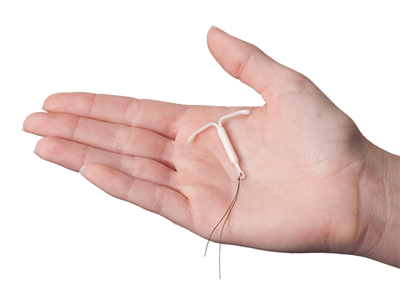The hormonal intrauterine device (IUD) is a small ‘T’ shaped plastic device with a hormone called levonorgestrel in the stem. There are two types of hormonal IUDs available in Australia. They are called Mirena and Kyleena. The Kyleena is slightly smaller than the Mirena and has a lower amount of hormone. The IUD is placed inside the uterus by a specially trained doctor or nurse to release the small amounts of the hormone for up to eight years.
How does it work?
- Thickens the mucus at the entrance to the uterus (cervix) to stop sperm from moving into the uterus.
- Thins the lining of the uterus to stop a fertilised egg implanting.
- Sometimes stops the ovaries from releasing an egg.
How well does it work?
Both types of hormonal IUD are very effective at preventing pregnancy. Mirena for up to 8 years and Kyleena up to 5 years. The Mirena IUD is 99.9% effective: the Kyleena IUD is 99.7% effective.
The hormonal IUD prevents unintended pregnancy for up to 5 to 8 years depending on the type.
What are the benefits?
- You don’t have to remember to take a pill every day.
- Periods usually become lighter and sometimes stop altogether.
- Starts working right away if it’s put in during the first seven days of your period.
- Fertility returns as soon as it’s taken out.
- Safe to use if you’re breastfeeding or can’t take oestrogen.
- An inexpensive form of contraception in the long term if you have a Medicare card.
What are the downsides?
- Hormonal IUDs don’t protect against STIs but you can use condoms at the same time.
- You may experience irregular vaginal bleeding in the first few months but in most cases this settles on it’s own. If there is troublesome bleeding, a GP can provide some options to manage it.
- It involves a procedure to put the IUD inside the uterus as well as when the IUD is removed. Putting the IUD into the uterus can be a bit painful, especially if you haven’t had children yet.
- There is a small chance it may come out by itself.
- There is a small chance of hormonal side-effects such as acne and breast discomfort.
Are there side effects?
It is rare to have serious health problems with the hormonal IUD. You may experience:
- cramping when it’s put in
- an increase in vaginal discharge
Other side effects are rare because of the low dose of hormones, but you may notice similar side effects to the progestogen-only pill (POP).
Can anyone use a hormonal IUD?
Most people can use a hormonal IUD.
Where do you get it?
A hormonal IUD must be inserted and removed by a trained doctor or nurse. This can be done at a Family Planning Australia clinic, by some GPs or a gynaecologist.



